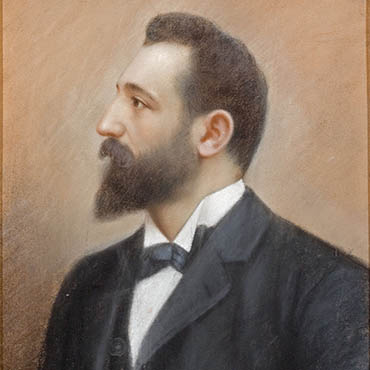Cermenati was born in Lecco in 1868. From his childhood he adored the mountains, a passion which he pursued for his whole life and which was perhaps the root cause of his interest in natural sciences. While he was still an adolescent he was collecting minerals, animals and plants and he was writing nature studies on Valtellina, also starting a journal, which did not last for long. Also still young he became a friend of Abbot Antonio Stoppani, a citizen of Lecco who was much older than him. He attended the technical institute in Sondrio and the Faculty of Natural Sciences at Turin; but, because he was interested in vulcanology, he took his degree in Catania and became the assistant of Alessandro Portis, lecturer in geology and palaeontology at the University of Rome. With the publication, under the title of Evoluzione e momenti storici delle scienze geologiche, of some lectures given at the Circolo dei naturalisti of Rome, he indicated the direction that his studies would mainly follow, that is, the history of sciences, based on first-hand documents according to the spirit of the age, even if they were often written in a learned and adulatory style.
The teaching of the history of natural sciences was the most enjoyable for him, and in 1902 he was awarded the chair at the University of Rome. Cermenati’s work aimed at promoting Leonardo da Vinci coincided with the last period of scientific activity of Antonio Favaro, which was focused on his work on Leonardo. Cermenati, the scholar, collector of documents, but also active organiser, appealed to all his political contacts in order to achieve the publication of Leonardo’s manuscripts.
In 1910 he became part of the Commissione vinciana, set up by Vittorio Emanuele Orlando, Minister of Education, and chaired by Pietro Blaserna. During the First World War the activities of the commission almost came to a halt. Cermenati himself, who had been elected to Parliament in 1909, had left to fight as a volunteer and resumed political life later, in 1917, as under-secretary in the Ministry of Agriculture, focusing his interest, among other things, on the management of the mines. In 1918 he succeeded Blaserna as president of the Commission, which went through a radical renewal with the incorporation of new people, including Antonio Favaro, who was also a member of the sub-commission for the transcription and publication of the Arundel Codex, with Cermenati as chair. His passion for Leonardo was further realised in the foundation of the Istituto di studi vinciani and in the celebrations, organised in Rome and Vinci, of the fourth centenary of the death of Leonardo, in which Antonio Favaro also participated with a contribution focused on the death itself, the tomb and the monument erected in Amboise. Mario Cermenati lived long enough to see the publication of the first part of the Arundel Codex and died in Castelgandolfo in 1924.


